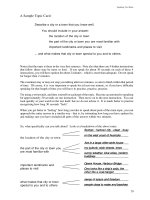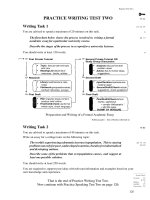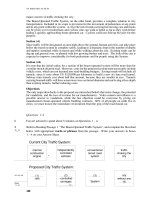Tài liệu 101 helpful hints for ielts part 10 pptx
Bạn đang xem bản rút gọn của tài liệu. Xem và tải ngay bản đầy đủ của tài liệu tại đây (148.98 KB, 15 trang )
101 Helpful Hints for 1ELTS
major concern of traffic choking the city.
The Beam-Operated Traffic System, on the other hand, provides a complete solution to city
transportation. Included in its scope is provision for the movement of pedestrians at any point
and to any point within the system. A city relieved of roads carrying fast moving cars and trucks
can be given over to pedestrians and cyclists who can walk or pedal as far as they wish before
hailing a quickly approaching beam-operated car. Cyclists could use fold-up bicycles for this
purpose.
Section (vi)
Since traffic will be designated an area high above the ground, human activities can take place
below the transit system in complete safety, leading to a dramatic drop in the number of deaths
and injuries sustained while in transit and while walking about the city. Existing roads can be
dug up and grassed over, or planted with low growing bushes and trees. The look of the city is
expected to improve considerably for both pedestrians and for people using the System.
Section (vii)
It is true that the initial outlay for a section of the beam-operated system will be more than for
a similar stretch of tarred road. However, costs for the proposed system must necessarily include
vehicle costs, which are not factored into road-building budgets. Savings made will include all
tunnels, since it costs about US $120,000 per kilometre to build a new six lane road tunnel.
Subway train tunnels cost about half that amount, because they are smaller in size. Tunnels
carrying beamed traffic will have a narrower cross-sectional diameter and can be dug at less depth
than existing tunnels, further reducing costs.
Objections
The only major drawbacks to the proposal are entrenched beliefs that resist change, the potential
for vandalism, and the loss of revenue for car manufacturers. Video camera surveillance is a
possible answer to vandalism, while the last objection could be overcome by giving car
manufacturers beam-operated vehicle building contracts. 60% of all people on earth live in
cities; we must loosen the immediate environment from the grip of the road-bound car.
Questions 1-4
6 You are advised to spend about 5 minutes on Questions 1 - 4.
8 Refer to Reading Passage 1 "The Beam-Operated Traffic System", and complete the flowchart
40~44 below with appropriate words or phrases from the passage. Write your answers in boxes
1 - 4 on your Answer Sheet.
Current City Traffic System:
internal
combustion
engine
*
independently
controlled
vehicles
conventional
tarred road
system
Proposed City Traffic System:
42-44-49
Check
11-15
(1)
rails
(2)
-controlled
carriages
.*..,» .
(3)
System
traffic
choking the
city
city
without any
(4)
140
Practice Test Four
Questions 5 - 9
You are advised to spend about 8 minutes on Questions 5-9. 6
Choose the most suitable heading from the list of headings below for the seven sections of 8
Reading Passage 1 "The Beam-Operated Traffic System". Write your answers in boxes 5 - 9 on 40'45"4€
your Answer Sheet.
A.
B.
C.
D.
E.
F.
Example: G.
H.
I.
List of Headings
Returning the city to the people
Speed to offset loss of car ownership
Automation to replace existing roads
A safe and cheap alternative
The monorail system
Inter-city freeways
Doing the sums
The complete answer to the traffic problem
Cleaner and more efficient
Q5. Section (ii) Q8. Section (v)
Q6. Section (hi) Q9. Section (vi)
Q7. Section (iv) Example: Section (vii)....(?..
Questions 10-12
You are advised to spend about 7 minutes on Questions 10 -12.
Refer to Reading Passage 1, and look at the statements below.
Write S if the statement is Supported by what is written in the passage, and write NS if the
statement is Not Supported. Write your answers in boxes 10 -12 on your Answer Sheet.
Example: The combustion engine was designed over 100 years ago.
9
42 / 45
9
Check
11-13-15
e
s
34-36
43
9
Q10. The increased speed of traffic in a Beam-Operated Traffic
System is due to electric motors being 90% efficient.
Q11. Beamed traffic will travel through tunnels costing less to
build than subway tunnels.
Q12. A possible solution to wilful damage to the System is to
install camera equipment.
S NS
NS
NS
52
43
44
Check
11-13-15
141
NS
101 Helpful Hints for IELTS
Reading Passage 2
Questions 13 - 26
You are advised to spend about 20 minutes on Questions 13-26.
6
38-44
54-56-57
Microcredit -
Helping to Alleviate
Third World Poverty
The application of prevailing theories of
economics has so far failed to lift developing
countries out of the cycle of poverty that
entraps the majority of inhabitants.
Worldwide there are still an estimated 1.3
billion people earning a dollar or less a day
and living in excruciating poverty. Decades
of huge loans by banks from affluent nations
- at interest rates that cripple developing
economies - do not appear to be providing a
solution to entrenched poverty. Professor
Muhammad Yunus' Grameen Bank,
however, is taking a different approach to the
problem.
In 1976, the Bangladeshi economics
professor embarked upon a microcredit
programme with a loan of just 62 cents (U.S.)
each to a group of 42 workers. Instead of
loaning large amounts of money to well-off
debtors, the bank he started made extremely
small loans to poor Bangladeshis who were
considered a bad risk by the traditional
banking system. He astounded his critics by
proving that the poor were more likely to
repay their debts than the wealthy. Virtually
none of the thousands of women who have
been financially assisted by the bank for over
20 years have defaulted on their payments.
Yet all are expected to pay interest and abide
by the rules of contract. These borrowings
have enabled Bangladeshi women to set up
numerous small-scale projects which directly
benefit their families and the communities in
which they live. The success of the experiment
has brought about a revolution in the way
anti-poverty programmes are now organised.
By the end of the century, almost 95% of
borrowers in Bangladesh were women, but
the bank did not set out to lend mainly to
women. At first, women were reluctant to
use the bank's services for fear of stepping
out of line in a strongly male-dominated
society. It took six years to reach a 50-50 ratio
of male and female borrowers. Over time, it
became apparent that improving the income
of women has positive effects that are lacking
when men are the beneficiaries. While men
are likely to take risks with the money they
have borrowed, women prove more capable
of planning for the future and improving the
family situation.
The Grameen Bank has loaned over $2
billion in Bangladesh to date. Over 3.5
million women from low income households
have benefited from its schemes, receiving
amounts that have increased to around $160
per loan. The bank claims a remarkable
repayment rate of 98%. It works in 36,000
villages throughout Bangladesh, employs a
staff of over 12,000, and has provided the
blueprint for similar microcredit programmes
working in over 56 countries, including the
United States of America, where poverty
remains an intractable problem in many large
cities.
Offering credit to poverty-stricken women
to start small enterprises is not the only way
in which the bankhas improved their financial
status. The bank is the largest internet service
provider in the country, and, in partnership
with a Norwegian telecommunications
company, lends cellular phones to borrowers,
mostly women, who generate income by
selling telephone services to the rural
population. A telephone lady can earn $2 a
day which amounts to $700 a year - more than
triple the average Bangladeshi annual per
capita income.
The success of the Grameen programme
continues to confound the experts. Their
reaction to Professor Yunus' bold plans to
bring solar and wind energy to isolated
communities, and to make the World Wide
Web available to the poor is much the same
142
Practice Test Four
as the reaction of the orthodox banks to his
initial concept - condemnation and disbelief.
It is sobering to reflect that despite the obvious
success of the model, microcredit still receives
only 2% of the world's $60 billion
development budget.
It is true that the new goals of the Grameen
programme are beyond mere banking and
will require the involvement and funding of
multinational companies and traditional aid
agencies. It is equally true that engaging the
poor to help with the removal of the poverty
in which they find themselves is now a
technique with a proven track record. This
not only addresses the problem at grassroots
level, but also preserves the dignity of those
who participate by avoiding the need for
charity.
Provided the latest extensions remain
fundamentally 'bottom up' solutions, it seems
sensible to believe they have more than a
small chance of success.
Number of ...
Branches
Centres
Villages
Borrowers
(mate)
Borrowers
(female)
Houses built
(with
Grameen
housing
loans)
(as at August 1998)
1118
66,352
38,766
124,248 (5.3%)
2,232,905 (94 7%)
448,031 (cumulative)
Figure 1. Grameen Bank Performance
Questions 13 -15
You are advised to spend about 5 minutes on Questions 13 -15.
Complete the information for the pie charts below by referring to Reading Passage 1 "Microcredit
- Helping to Alleviate World Poverty". Write your answers in boxes 13 -15 on your Answer
Sheet. The first one has been done for you as an example.
s
8
52
54
54
9
1976
Gender of borrowers:
Q13
Q14
(Ex:)
Q15.
94.7%
58
Check
11-15
143
101 Helpful Hints for IELTS
Questions 16-21
e You are advised to spend about 7 minutes on Questions 16 - 21.
s Refer to Reading Passage 1, and link the phrases in Questions 16-21 with either:
44-46-49
TB
GB
MB
FB
A
or N
Traditional Banks
the Grameen Bank
Male Borrowers
Female Borrowers
All of the above
None of the above
Write your answers in boxes 16 - 21 on your Answer Sheet.
Q16. thought that poor Bangladeshis would default on their loans
Q17. providing a model for other poverty relief programmes to follow
Q18. initially unwilling to borrow funds
Q19. often careless with the money they have been loaned
Q20. not likely to be unable or unwilling to repay debts
Q21. either paying or charging interest on their loans
Questions 22 - 26
6 You are advised to spend about 8 minutes on Questions 22 - 26.
8 Complete the following statements with words or phrases from Reading Passage 1 "Microcredit
12-65 - Helping to Alleviate World Poverty". Write your answers in boxes 22 - 26 on your Answer
46-53 Sheet.
Note that each answer requires a MAXIMUM OF FOUR WORDS.
Q22. The interest rates that banks from wealthy nations charge
65 Q23. After six years, the Grameen Bank was lending money to an equal
number of
Q24. Even in wealthy countries, poverty still exists in
Q25. Women with cellular phones can earn three times the average wage
by to villagers.
53 Q26. Professor Yunus hopes to interest existing aid organisations and
Check. in his latest plans.
11-15
144
Practice Test Four
Reading Passage 3
Questions 27 - 40
You are advised to spend about 20 minutes on Questions 27 - 40.
A.D.D. - Missing Out on Learning
Study requires a student's undivided attention. It is impossible to acquire a complex skill or
absorb information about a subject in class unless one learns to concentrate without undue stress
for long periods of time. Students with Attention Deficit Disorder (A.D.D.) are particularly
deficient in this respect for reasons which are now known to be neurobiological and not
behavioural, as was once believed. Of course, being unable to concentrate, and incapable of
pleasing the teacher and oneself in the process, quickly leads to despondence and low self-
esteem. This will naturally induce behavioural problems.
It is estimated that 3 - 5 % of all children suffer from Attention Deficit Disorder. There are three
main types of Attention Deficit Disorder: A.D.D. without Hyperactivity, A.D.D. with Hyperactivity
(A.D.H.D.), and Undifferentiated A.D.D.
The characteristics of a person with A.D.D. are as follows:
• has difficulty paying attention
• does not appear to listen
• is unable to carry out given instructions
• avoids or dislikes tasks which require sustained mental effort
• has difficulty with organisation
• is easily distracted
• often loses things
• is forgetful in daily activities
Children with A.D.H.D. also exhibit excessive and inappropriate physical activity, such as
constant fidgeting and running about the room. This boisterousness often interferes with the
educational development of others. Undifferentiated A.D.D. sufferers exhibit some, but not all,
of the symptoms of each category.
It is important to base remedial action on an accurate diagnosis. Since A.D.D. is a physiological
disorder caused by some structural or chemically-based neurotransmitter problem in the nervous
system, it responds especially well to certain psychostimulant drugs, such as Ritalin. In use since
1953, the drug enhances the ability to structure and complete a thought without being
overwhelmed by non-related and distracting thought processes.
Psychostimulants are the most widely used medications for persons with A.D.D. and A.D.H.D.
Recent findings have validated the use of stimulant medications, which work in about 70 - 80%
145
38-44
40-51-54









